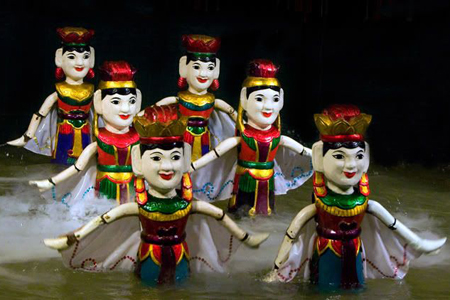With the history of 4000 years, generations of Vietnamese people have created and maintained a lot of traditional arts and water puppetry is the best one among them. Enjoying a water puppet show will show you not only the outstanding performance but also the long-established culture, tradition, and customs of the S-shaped country. People often said that it is often a great mistake if you do not watch the Vietnamese traditional puppet show in your Vietnam vacation.
History of Traditional Vietnamese Water Puppetry
"The golden tortoise, swimming in a leisurely way, carries three mountains on its head above the rippling waves, its carapace, its feet visible in the clear slow-moving waters. Casting a glance at the bank, it opens its mouth to spurt waters towards the jetty, turns its face up to admire the king's crown, then bows its head to examine the immense sky (the clouds mirrored in the water, and the steeply-rising escarpment. A Courtly musical prelude is played, the door to the grotto opens and fairies appear in a dance entitled The Wind Comes while singing in praise of Good Fortune; flocks of birds dance and twitter, herds of innocent deer jump for joy.
In the above-mentioned passage from ancient literature, the scholar Nguyen Cong Bat was clearly describing a scene from water puppetry possibly attended by the then King. Similarly, several literary works by Phan Truong Nguyen (12th century) and others by King Tran Thai Tong (1225-1258) appear to confirm that water puppetry was a courtly entertainment during the reigns of the Ly and Tran dynasties. The history of Vietnam is one of the successive wars which left in their wake destruction of the nation's monuments and heritage. Only humble examples of water puppet theatres remain, such as the pavilion at Thay Pagoda, built in the Later Le period (about 1533-1708) and the one at Dong temple, built in 1775.
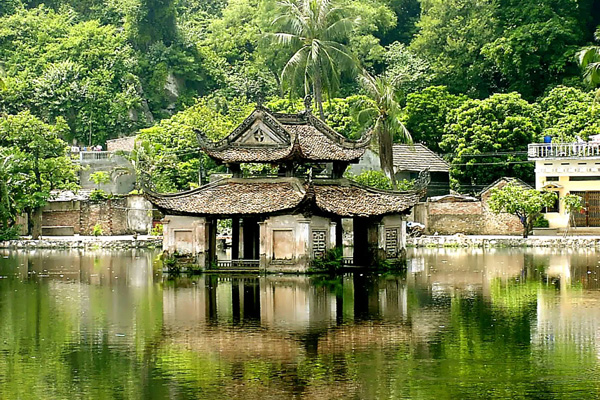
The above-mentioned historical inscriptions confirm that water puppetry was in vogue in the court of the 11th century, and the existence of such records indicate that it must have existed even earlier in the rural villages where it was first performed. At agrarian festivals in rice-growing areas, one of the earliest forms of religions was the offering of prayers to various deities for good crops, since the results of the peasant's labor depended heavily on seasonal rainfall. The ritual water procession has been preserved virtually in its original form, with its many water-related objects and activities both concrete and abstract, from releasing a captured aquatic creature back into its environment, washing statues of the Buddha and various deities, leaning pagodas with water, people bathing and washing, and so on, to prayers for rain and games which take place in water
such as swimming contests, rowing competitions, and water puppetry.
Apart from taking rural religious belief as to the probable origin of water puppetry, it is also important to highlight a number of material factors which enable peasants to develop this form of entertainment by themselves. Since the beginning, they have utilized rudimentary materials that were always within reach, and the simple handicraft techniques, as well as mechanical control principles, were always available. The paddy fields, rivers, canals, lakes, and ponds of the Northern Delta provided a favorable natural environment that inspired and facilitated the development of entertainments requiring little effort to find or create. Rice cultivation techniques, together with associated traditional occupations and customs, including pastoral amusements, gave rise to water puppetry, a form of folk culture originating from the natural environment and in complete harmony with nature. We cannot be sure of precise details regarding the origins of water puppetry. But it is certain that it was the countryside of Vietnam, particularly the Red River delta that preserved and nurtured this unique traditional theatrical art over many centuries.
Literature in Traditional Vietnamese Water Puppetry
As with all forms of ground (or ordinary) puppetry, water puppetry originally consisted of acting without words (mime). The part played by literature comprises script-writing and word composition, all based on traditional methods used to formulate puppetry scenes. In other words, the gestures are perfected first, then the words of the character are composed, depending on the results of the characters' actions and circumstances.
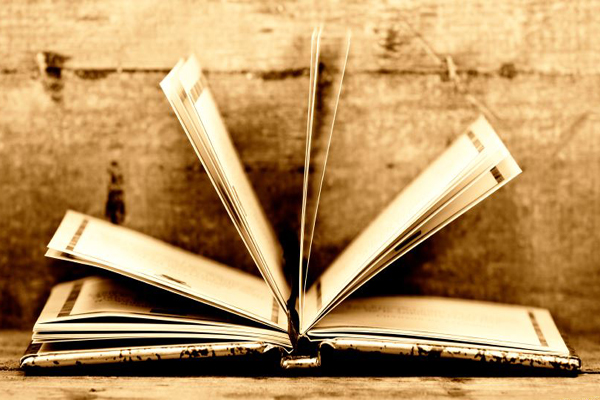
The words are usually composed using verse derived from sudden inspiration, not always in accordance with the gestures of the characters. For instance, a lonely fisherman speaks of La Vong's fishing; a horseman speaks of how Kwan Yu rode his black horse. The words of water puppetry scenes deliberately remind the audience of the stories behind the gestures.
In these circumstances, the use of Nom words, a variant of Chinese, can partly reduce the aesthetic value of the scenes. Scenes in Nom were usually compiled by village teachers who used various historical references and ascribed them to the activities of the characters. The main element of literary value which is suitable for water puppetry is folk poetry and folk songs (See Appendix). Such rhyming texts describe work and everyday activities in words that are usually simple, cheerful, and full of strength.
The words of scenes with stories borrowed from Tuong and Cheo are short extracts modified enough to introduce the contents of these excerpts and make them suitable for water puppetry. This is why the narrations of puppetry swiftly bring them back to the familiar storylines. Water puppetry was originally a form of mime. The literary works appeared later than the performing art and its folk character is clearly expressed invariants on the words of conversations and songs.
Music in Traditional Vietnamese Puppetry
Traditional water puppetry used percussion instruments to accompany the gestures, keep up the rhythm of the performance, and create an atmosphere of great animation. The main traditional instrument used are drums (both large and small), cylindrical drums, wood and bamboo bells, gongs, horns, and shells. Firecrackers, in addition to constituting their own scenes, also provide sound effects for others. Although there are songs in some water puppetry scenes, no distinctive music of its own has yet appeared with rhythm playing the main role.
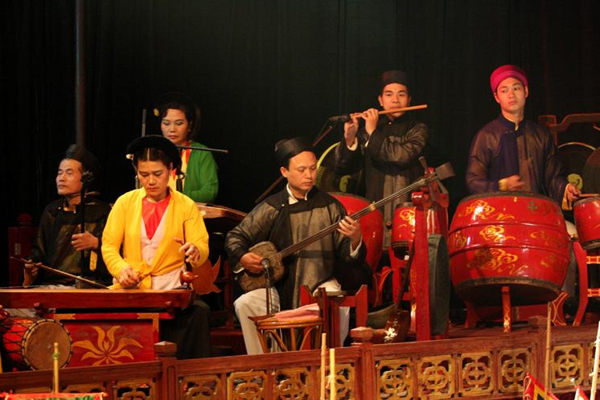
Scenes & Stories in Vietnamese Traditional Puppetry
Groups of Scenes
Based on the contents of one principal scene, a number of individual vignettes can be performed in sequence in the form of sketches or groups of scenes; the vignettes will, however, wholly retain its separate identity. According to the program, a single scene can be performed separately or included in a group of scenes. Examples of these are "plowing" and "harrowing", included in the group of scenes called "Four rural occupations" (fisherman, woodcutter, plowman, and herdsman), the group of scenes called "Five castes" (scholar, peasant, worker, trader, and soldier), the "Farming" group of scenes (plowing, harrowing, hoeing, rice transplanting, tending) and the "Fishing" group of scenes (fishing by means of fishing rods, nets, dip nets, traps and so on). The puppet characters are also organized in a similar manner; they take part in "Tending buffaloes" and then "Buffalo fighting" and so on (see Appendix for the list of water puppet scenes).
Individual Scenes
Stories are generally drawn from already existing single scenes or excerpts from Tuong and Cheo plays. Only those excerpts that can be adapted to water puppetry are selected. These often full of actions, but avoid the expression of the innermost feelings, which are beyond the capabilities of the puppet.
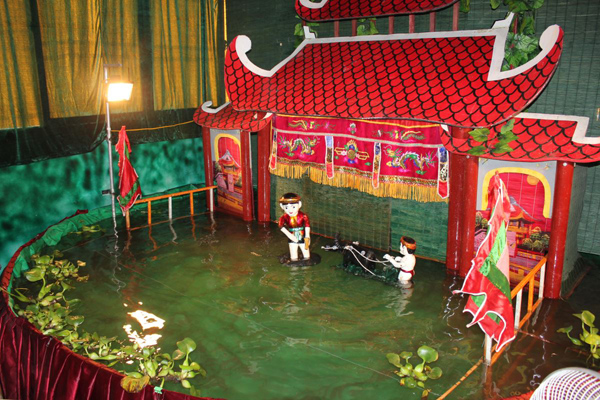
A number of stories use excerpts from Tuong and Cheo plays - The delivery of the prince and the severing of Khuong Linh Ta's head (from the Tuong play Son Hau). - The fairy's sighting of Tu Thuc (from the Cheo play Tu Thuc). -Thi Mau returning her baby (from the cheo play Quan Am Thi Kinh. - The Xich Bich firefight (from the tw5ng play The Three Warring States). - The dance of the eight fairies and rowing (from the cheo play Luu and Nguyen in the Fairyland). Combining various scenes in order to interpret a legend means a further step toward a performance based on a script, and in this way of the scene can become a show with a story, te sow e LYI s insurrection, or example. The single scenes needed to make it a show with stories are briefly as follows: - Prelude, an introduction to the story. -The scene "Farming" (from "The Four Rural Occupations") - Le Loi plowing the fields; - The scene "Horse racing" – Le Loi and Lieu Thang fighting each other on horseback. - The scene "Fishing" (from "the Four Castes") - Le Loi going sailing on the lake.
The Artists & Guilds in Vietnamese Traditional Water Puppetry
In traditional Vietnamese society, there were no professionals in water puppetry. The title of water puppetry artist used to designate a person who participated directly in the various aspects of work in this genre of theatre did not specifically denote a profession, income, or social background. In Vietnamese tradition, age is regarded as indicating a man's status in his community; the older he was the more he was referred to by the community.
Experience and the inherited experience was the only way of accumulating knowledge, thus requiring one first to pass through a certain number of years of one's life. Moreover, in rural Vietnam, a middle-aged or older man could accede to the position of head of the family, which conferred virtual ownership of or the right to use his house, garden, and land as well as authority over family members. Only with this status could people take part in the affairs of the village and support their own activities as members of a guild through their own efforts, time, and family resources. Few women were engaged in water puppetry because they were regarded as not physically fit enough to stand for long periods in muddy water to manipulate the puppets, and few in the old days were head of families and particularly because, in keeping with professional practice, it was feared that they might disclose the secrets of a puppetry troupe to their husbands' families.
All the work of water puppetry was learned through visual observation and imitation, constantly bringing a high level of proficiency. Few artists or artisans severed their links with water puppetry to take up other professions, although several of them were excellent at each specific task; for instance, elderly artisan Phan Van Huyen, a puppet-caving expert of the Rach guild, (Nam Dinh province); Tong Quynh, Pho Phien, Ly Muc, Nguyen Xuan Truong and Nguyen Ba Chu of the Nguyen guild (Thai Binh province), all experts in devising puppet-manipulating mechanisms, and Pham Viet Vien and Nguyen Van Luyen of the Dong guild (Thai Binh) who are skilled in puppet manipulating.
A guild is a professional craft association in each village. Its activities are based on regulations drawn up by its members in written or non-written form. Each water puppetry guild has its own statues. The villages establish such an organization, then need only to inform the local authorities of its existence. A water puppetry guild is usually founded by a person enjoying great prestige either thanks to age, profession, or property, but the person who manages it is known as the chief and is elected by its members. The guild is named after the village, for instance, the Rach guild or Dong society or after a hamlet - the Tay Trong and Tay Ngoai guild.
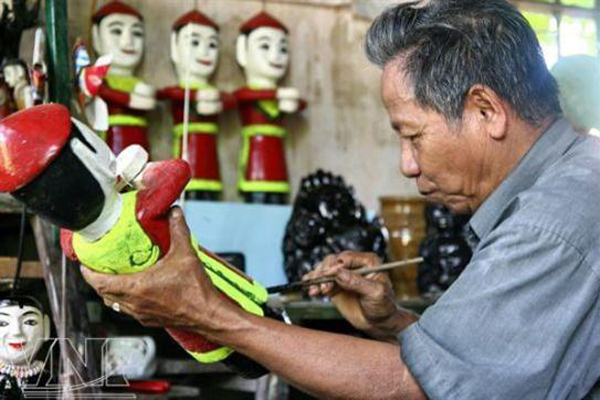
Every year on the anniversary of the founder's death, the guild admits those applying for membership. The priority of admission accorded to the children or grandchildren of existing members and admission procedures are defined by each association. Prospective members are usually requested just to be decently dressed, bring a bottle of rice wine and a tray of betel rolls and areca nuts to the altar of the founder, and then present themselves before the guild. When accepted, a person has to drink vermilion (symbolizing human blood) and take an oath. The oath in essence is a promise to strictly keep the secrets of the guild or society; any disclosure is at the cost of "the life of the father and of three successive offspring".
Apart from functioning as a cultural organization, a puppetry guild is also a mutual aid society. When a member's parent is ill, the guild assumes the responsibility of donating a sum of money or assistance in kind and making arrangements for marriages or funerals as well. The members of a guild, therefore, are not only directly engaged in professional activities, but also enter either for altruistic purposes or for the glory of being entitled to a place of honor at rural festivals. For these reasons, an association may have as many as a hundred members, but with only 20-25% of these possessing some professional know-how. The role of a water puppetry guild is first and foremost to take part in traditional village festivities, so it is recognized by the latter as an organization working for the public benefit. Guild members are, therefore, entitled to every privilege at public events, as are their counterparts from other village organizations (the phe giap), drummers society, octette society'", elders' society, rice traders' guild, asons' guilds, and so on). Some of the guilds are allocated land and ponds by their local authorities; others receive symbolic honor awards, such as strings of firecrackers, trays of betel rolls and areca nuts, or a few pieces of red silk. Water puppetry is not a means of supporting one's existence. People with an interest in it usually gather together in a guild and contribute their own rice and money towards a fund which will be handed down from generation to generation, sometimes there are donations from the altruistic and advance security money from the lonely. The funds may grow through the purchase of farmland or lending at low-interest rates. Usually, the guilds are able to buy ponds which they use both for rearing fish and performances. In some cases, they can earn from regular annual he setting up or dismantling of a manipulation room or stage.
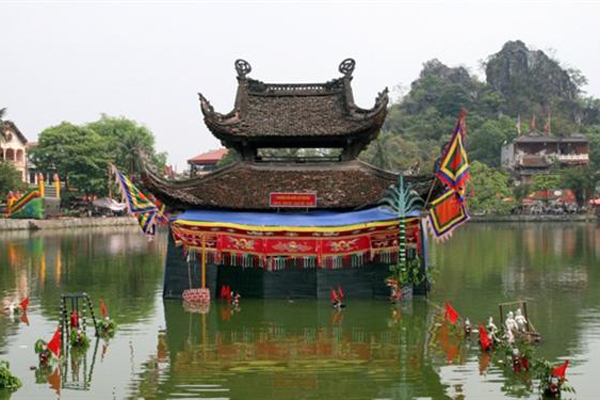
Like other professional organizations in Vietnamese society, the water puppetry guild or society emerged very early. Partly reflecting the traditional fabric of society in Vietnam, the practice of keeping professional secrets has all along restricted the possibility of exchanges among guilds from village communities. But this at the same time has stimulated and resulted in a diversity of form, control techniques, and mechanisms within each guild itself. The structure of the guild or society is well suited to the social conditions, customs, and lifestyles of each locality, thus helping to preserve and develop the art of Vietnamese water puppetry through a multitude of changes in social and historical background.
Some Typical Vietnamese Traditional Water Puppetry Scenes
Flag Raising (Nguyen Guild)
The opening scene on the water's edge before the stage, the audience grows impatient, waiting for the show to start amid the stirring sound of drums, wooden bells, and horns. Suddenly everyone is startled by a loud "boom" from an exploding king-sized firecracker and, to their surprise, the audience beholds rows of flags and parasols springing up from under the water and fluttering in the breeze, forming a spectacular border around the stage, and seemingly without a drop of water on them.
Dance of the Fairies (Nguyen Guild)
Accompanied by music and a prologue, two fairies in resplendent attire appear from behind the screens. They step out, performing a graceful dance. When they disappear behind the screens again, eight more fairies make their entrance in pairs, one after another dancing and singing to the melodious accompaniment of flutes and other Vietnamese instruments.
Water-spurting Dragon (Nguyen Guild)
A beautiful dragon comes on stage. It twists and turns, coiling and uncoiling its golden body and spurts water, lifts its head, and waves its tail while swimming across the surface. It then catches hold of the gate and climbs up, creeping along the horizontal beam, turns its head to spurt water then climbs back down to perform a dance before exiting to the manipulation room.
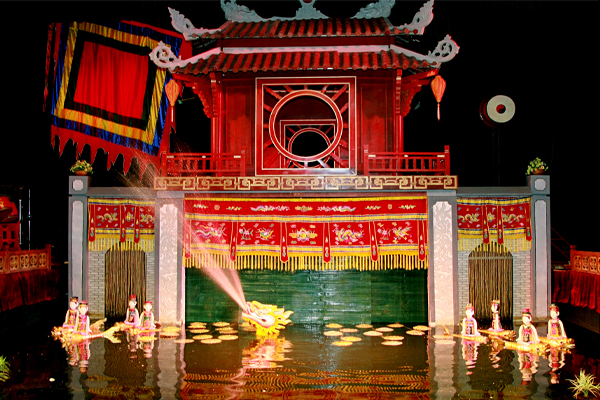
Dance of the Four Sacred Creatures (Chang San Guild)
A pair of dragons dances, spurting fire, and water. A phoenix opens its beak and spreads its wings to fly. A golden tortoise stretches its neck, then retracts its head and move its feet. Two unicorns skim across the water's surface. These four sacred creatures then dance gracefully together.
Two Fan Fight over a Ball (Dong Guild)
Two Ian (lions) come on stage to the sound of drumbeats. A ball appears. The beat of the drum gradually quickens. The two Ian rush for the ball. Waves roll across the surface of the water. The ball bobs and slips away from the animals, who had failed to catch it, now lie in wait. The ball keeps emerging and disappearing, teasing them. They lift their heads, open their eyes a little wider and edge their way silently forward to pounce on it. The mischievous ball vanishes again. The hunt is energetic but in vain. The audience is kept breathless with excitement by this game of hiding - and - seeking. The sequence comes to an end when both animals grab the ball and move around the stage displaying it to thank the audience for their encouragement.
Swinging (Dong Guild)
A young girl in flowing robe, wearing on her head the traditional rolled headband from the end of which emerges a short pigtail, comes on stage and does a tour of it. Then she draws nee a swing, sits on it, and flexes her legs in order to make the swing move skywards. She then stops the swing, gets off it, and doe another tour of the stage to greet the audience.
Ta loses his Head (Dong Guild)
Ta On Dinh is hunting down Dong Kim Lan, escort ( the royal concubine and the prince who have just fled to San Hau. Khuong Linh Ta is in On Dinh's way. Ta's head is severed but h stoops to pick it up and runs away with it. Frightened, On 81n does not dare to continue with the chase (excerpt from the tuong play "San Hau").
Thi Mau Returns her Baby (Nhan Hoa Guild)
Lady Thi Kinh disguised as a Buddhist monk is chanting prayers and striking a wooden bell. Thi Mau brings her newborn baby and tells a lie that it is the unwanted result of a pregnancy for which the "monk" is responsible. She, therefore, returns it t "him". Unable to prove her innocence, merciful Th] Krnh accepts the baby from Thi Mau and takes the baby away to go begging (excerpt from the cheo play "Quan Am Thi Kinh").
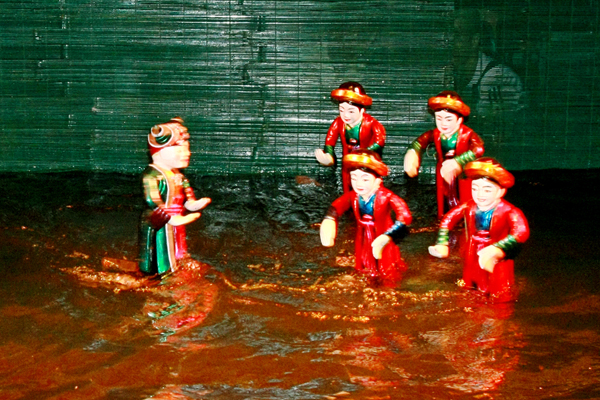
Wrestling (Nhan Hoa Guild)
Two wrestlers, both naked to the waist and wearing on! loin-cloths, present themselves on stage for a prizefight. The' prove to be adversaries of equal strength after many rounds ani neither is able to win. The show comes to an end when one of the two wrestlers backs touches the "ground".
Horse Racing (Rach Guild)
A chestnut and a white steed gallop along in a race. Two neatly dressed young horsemen watch them attentively from where they stand. From a chosen vantage point in front of the animals, each of the lads jumps on one horse and spurs it on to greater speed. The two even compete with each other in their skill at jumping on and off horseback.
Offering Flowers from the Backs of Fishers (Rach Guild)
Against a backdrop of rhythmic drumbeats and the chiming of wooden bells, the sound of string instruments and flutes float through the air as three fairies, each riding on a large fish, come on stage. They hold trays of betel rolls and areca nuts and beautiful bunches of flowers with which to greet the audience. When the flowers and betel rolls arrive in the hands of a representative of the audience, the latter are so enthusiastic that they pass money to the representatives who places it on a tray as a recognition of the guild's talents. The fairies carry the tray back to the artists in the manipulation room.
Jumping from Horse to the Hammock (Dao Thuc Guild)
An orange-colored hammock is carried on by two guards, with a mandarin sitting in it. Another guard, leading e group is moving forward, the Mandarin mounts the horse in order to ride it. After a short distance, the mandarin jumps down from the horse into the hammock. The same action and vice-versa is performed several times across the stage.
Planting & Pulling up Flags (Bo Guild)
Emerging from the manipulation room, a character solemnly holds up a flag and marches to the outer edge of the stage, where he plants it then makes his exit. The flag flutters at the top of its pole. At the end of the show, the flag holder again emerges to pull up the flag, which he marches solemnly back to the manipulation room.
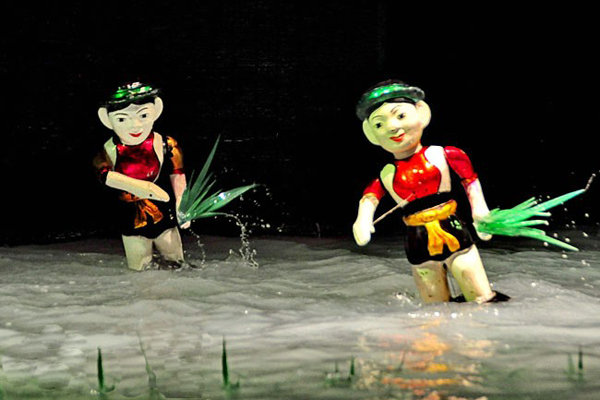
Carrying the Palankeen (Yen Thon Guild)
A procession is underway as part of a village festival. What stands out in relief in the midst of the procession is a beautiful vermilion-colored palankeen with four poles carries by eight bearers. The procession stops at the right-hand lean-to. A mandarin enters the lean-to, from which he takes out the statue of a deity which he puts on the palankeen. The procession resumes its match and stops at the left-hand lean-to. The Mandarin takes the statue from the palankeen carrying it. Then he is seen taking out a statue of the Buddha which he has put on the palankeen. (The scene is also entitled "Out with a Deity and in with the Buddha").
Five-direction Funeral March (Nguyen Guild)
The five branches of five makeshift funeral platforms'" flutter at the four corners and in the middle of the stage. A middle-ranking bonze wearing a chela holding high a parasol and a Buddhist nun with hands clasped. The three of them march single file around each platform, in turn, three times clockwise and three times counter-clockwise.
Buffalo Fighting (Bui Thuong Guild)
A pair of gigantic buffaloes, one black and one white with a curved horn on stage from both wings, shaking their horns as they advance towards each other. The village drums keep increasing their rhythm. The buffaloes rush at each other, head to head, horns interlocking, trying now to pull the ther down, now to lift him up, inching forward then withdrawing in an effort to win a swift victory. The water surface erupts in waves. The white buffalo, short of strength, turns and runs away, followed by the black one sensing victory. The fight will continue with many more rounds fought around the pond (beyond the stage).
Tightrope Walking (Nguyen Guild)
A tiny "acrobat" emerges from under the water and climbs up a rope, then he walks across another rope stretched across the stage. He also does somersaults on the rope, clinging to it with his feet swinging in the air.
Dip Net fishing (Dong Ngu Guild)
An impression of great animation is created on stage by the struggling movements of a huge shoal of fish, big and small. They keep swimming, dividing, and struggling. Some of them fling themselves 5-7 meters beyond the stage.
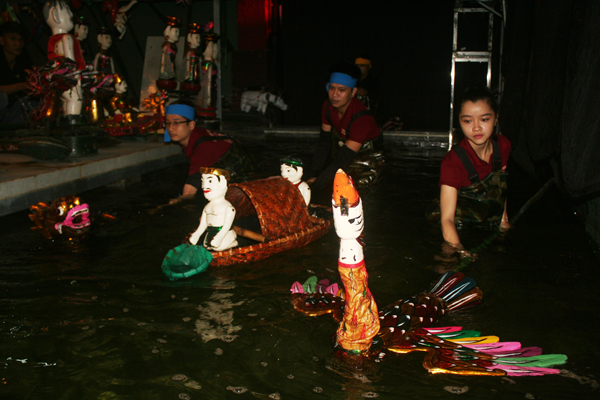
A group of fishermen, each armed with either a basket trap or dip net, stream on to the scene. The fish have washed aside and try to escape. A couple of fisherfolk are aboard a bamboo boat, the wife at the oats, and the husband casting his dip net. Some of the fish, trapped in the leap out and the movement of the water capsizes the fishing boat and throws the people overboard.
Farming (Phu Da guild)
To the lilting sound of buffalo-bay's flute, plowmen can be seen wading through a paddy field with their buffalo. A group of rice transplanters nimbly take handfuls of seedlings from sheaves held under their arms and plant them in the earth. In the distance, a young woman and a young lad are busy husking and pounding rice.
Tending the Ducks & Beating the Fox (Nguyen guild)
An old man and his wife carry on stage a flat basket full of eggs. In an instant, a flock of ducklings hatches forth. The old people wave banners, driving them along to seek shrimp and small fish. The ducks swim and dive nosily in search of food and dispute with one another, at times huddling together then breaking loose. A fox steals onto the stage, intending to catch a duckling, but is driven away by the old couple. One of the ducklings, engrossed in looking for food, breaks away from the flock and goes too near the fox. The fox grabs it. The old couple pursues the fox around the stage but fails to catch it. The fox takes the poor duckling into a clump of grass and climbs a tall tree. The old duck tenders raise their faces to stage indignantly in the fox.

